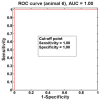Laser induced breakdown spectroscopy for bone and cartilage differentiation - ex vivo study as a prospect for a laser surgery feedback mechanism
- PMID: 25426327
- PMCID: PMC4242035
- DOI: 10.1364/BOE.5.004013
Laser induced breakdown spectroscopy for bone and cartilage differentiation - ex vivo study as a prospect for a laser surgery feedback mechanism
Abstract
Laser surgery enables for very accurate, fast and clean modeling of tissue. The specific and controlled cutting and ablation of tissue, however, remains a central challenge in the field of clinical laser applications. The lack of information on what kind of tissue is being ablated at the bottom of the cut may lead to iatrogenic damage of structures that were meant to be preserved. One such example is the shaping or removal of diseased cartilaginous and bone tissue in the temporomandibular joint (TMJ). Diseases of the TMJ can induce deformation and perforation of the cartilaginous discus articularis, as well as alterations to the cartilaginous surface of the condyle or even the bone itself. This may result in restrictions of movement and pain. The aim of a surgical intervention ranges from specific ablation and shaping of diseased cartilage, bone or synovial tissues to extensive removal of TMJ structures. One approach to differentiate between these tissues is to use Laser Induced Breakdown Spectroscopy (LIBS). The ultimate goal is a LIBS guided feedback control system for surgical laser systems that enables real-time tissue identification for tissue specific ablation. In the presented study, the authors focused on the LIBS based differentiation between cartilage tissue and cortical bone tissue using an ex-vivo pig model.
Keywords: (170.1020) Ablation of tissue; (170.1470) Blood or tissue constituent monitoring; (170.6935) Tissue characterization; (300.6365) Spectroscopy, laser induced breakdown.
Figures





Similar articles
-
Qualitative tissue differentiation by analysing the intensity ratios of atomic emission lines using laser induced breakdown spectroscopy (LIBS): prospects for a feedback mechanism for surgical laser systems.J Biophotonics. 2015 Jan;8(1-2):153-61. doi: 10.1002/jbio.201300159. Epub 2013 Dec 23. J Biophotonics. 2015. PMID: 24376030 Free PMC article.
-
Multimodal feedback systems for smart laser osteotomy: Depth control and tissue differentiation.Lasers Surg Med. 2023 Dec;55(10):900-911. doi: 10.1002/lsm.23732. Epub 2023 Oct 23. Lasers Surg Med. 2023. PMID: 37870158
-
The differentiation of oral soft- and hard tissues using laser induced breakdown spectroscopy - a prospect for tissue specific laser surgery.J Biophotonics. 2017 Oct;10(10):1250-1261. doi: 10.1002/jbio.201600153. Epub 2016 Nov 22. J Biophotonics. 2017. PMID: 27875030
-
Medical application of laser-induced breakdown spectroscopy (LIBS) for assessment of trace element and mineral in biosamples: Laboratory and clinical validity of the method.J Trace Elem Med Biol. 2023 Sep;79:127241. doi: 10.1016/j.jtemb.2023.127241. Epub 2023 Jun 12. J Trace Elem Med Biol. 2023. PMID: 37393771 Review.
-
Temporomandibular Joint Osteoarthritis: Pathogenic Mechanisms Involving the Cartilage and Subchondral Bone, and Potential Therapeutic Strategies for Joint Regeneration.Int J Mol Sci. 2022 Dec 22;24(1):171. doi: 10.3390/ijms24010171. Int J Mol Sci. 2022. PMID: 36613615 Free PMC article. Review.
Cited by
-
Assessment of the Electrolyte Heterogeneity of Tissues in Mandibular Bone-Infiltrating Head and Neck Cancer Using Laser-Induced Breakdown Spectroscopy.Int J Mol Sci. 2024 Feb 23;25(5):2607. doi: 10.3390/ijms25052607. Int J Mol Sci. 2024. PMID: 38473853 Free PMC article.
-
Remote photoacoustic sensing using speckle-analysis.Sci Rep. 2019 Jan 31;9(1):1057. doi: 10.1038/s41598-018-38446-x. Sci Rep. 2019. PMID: 30705342 Free PMC article.
-
The role of potassium in depth profiling of the tumor border in bone-invasive oral cancer using laser-induced breakdown spectroscopy (LIBS): a pilot study.J Cancer Res Clin Oncol. 2023 Dec;149(18):16635-16645. doi: 10.1007/s00432-023-05411-9. Epub 2023 Sep 16. J Cancer Res Clin Oncol. 2023. PMID: 37716922 Free PMC article.
-
Methodology for the Implementation of Internal Standard to Laser-Induced Breakdown Spectroscopy Analysis of Soft Tissues.Sensors (Basel). 2021 Jan 29;21(3):900. doi: 10.3390/s21030900. Sensors (Basel). 2021. PMID: 33572796 Free PMC article.
-
Elemental analysis of tissue pellets for the differentiation of epidermal lesion and normal skin by laser-induced breakdown spectroscopy.Biomed Opt Express. 2016 Apr 4;7(5):1626-36. doi: 10.1364/BOE.7.001626. eCollection 2016 May 1. Biomed Opt Express. 2016. PMID: 27231610 Free PMC article.
References
-
- Dworkin S. F., Huggins K. H., LeResche L., Von Korff M., Howard J., Truelove E., Sommers E., “Epidemiology of signs and symptoms in temporomandibular disorders: clinical signs in cases and controls,” J. Am. Dent. Assoc. 120(3), 273–281 (1990). - PubMed
-
- McNamara J. A., Jr, Seligman D. A., Okeson J. P., “Occlusion, Orthodontic treatment, and temporomandibular disorders: a review,” J. Orofac. Pain 9(1), 73–90 (1995). - PubMed
LinkOut - more resources
Full Text Sources
Other Literature Sources
